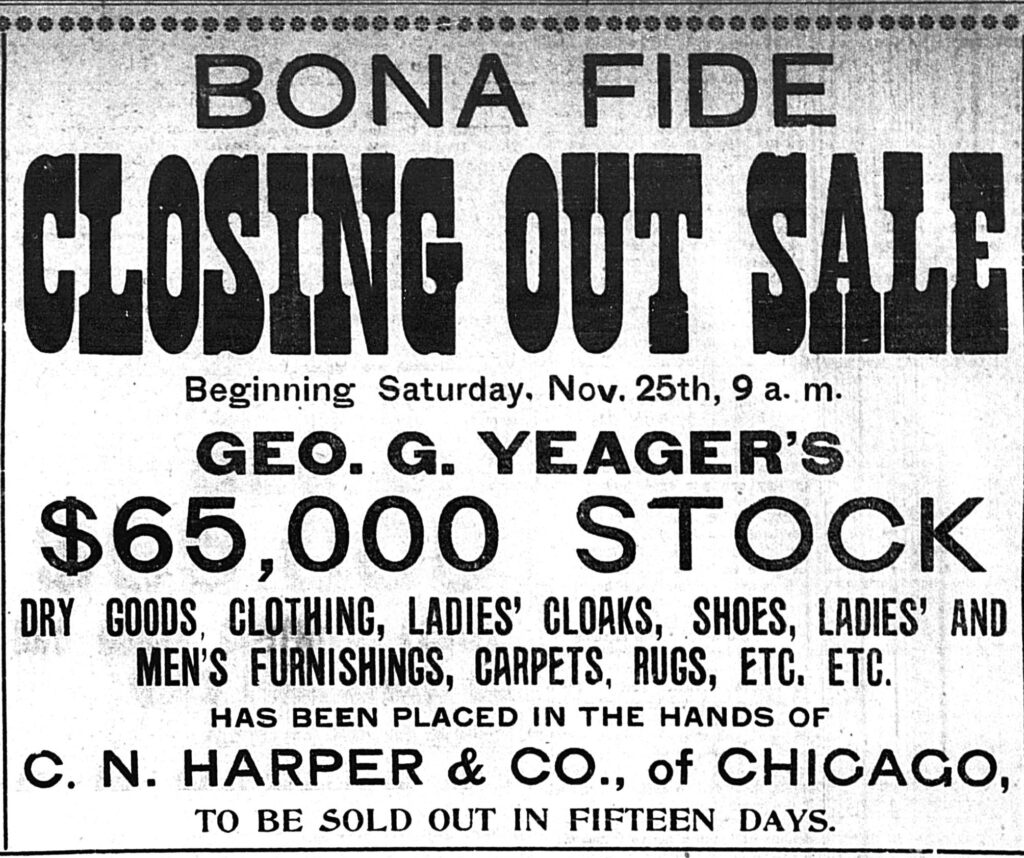
The year is 1847, and a man named Samuel Yeager was the owner and captain of a steamboat called the “John B. Gorden.” He was headed to Fairmont, W.V., loaded with 70 tons of freight. Now, what was a seaman to do with all the merchandise he had purchased elsewhere? He unloaded it, stored it in town, and made a few more trips to gather additional items. He had made his mind up that he was tired of the sea and decided that when he had an adequate amount of merchandise, he would open a shop for himself and later bring his son George into the business.
In 1856 he opened a small trading business, and as it grew, he built a general store for all to come to; by then, his son George was also made a partner in the store. The business was a continued success until Samuel’s death in 1893. I could not find the exact location of this first store in Fairmont, but George decided he needed a larger, more spacious store. He bought some property on the corner of Fairmont’s Main St [Adams St now} and Madison St. He engaged the best architect around the area, Andrew Lyons, who had made a name for himself designing other well-known buildings in town. This would be the birth of a building that would not only hold the Yeager business but, as time marched on, would hold three other department stores, two of which would continue into my childhood.
The Yeager Building was born!
A little side note here, George’s mother was the daughter of Rolley Dent of Morgantown. Rollie was the ancestor of Julia Dent Grant, the wife of Ulysses S. Grant. Just thought that was an interesting fact.
The building was to be created in such a design that no other building in town would come close to its appearance. Made out of bricks from the local brickyard, it would have two large arched Carrara glass front windows that would span the two top floors of the building. For years to come, these windows were the showcase of the building. The store was always meant to be light and airy, so along with the arched windows, the front of the building had eight other windows that could be opened for fresh air.
George was so excited with his new establishment that when it was being prepared for the opening, he stretched the largest piece of canvas he could purchase across the front of the building so that no one could see what was happening.
The grand opening of the Yeager building and store was a real celebration. Hundreds would come from all over to enjoy the orchestra playing in front of the store. Inside there were so many bargains I’m sure everyone left with a purchase. There was merchandise from the basement to the top floor. Whatever you needed, they had.
They had installed the latest devices, such as the Lamson Electric Rapid Cash Carrier. It was a pneumatic tube system that the salesperson would use to send the sales ticket along with the money, to the cashier, who would then return the change and receipt back to the customer. Mrs. Yeager, at the time, was the cashier.
Business was good, but George’s health was starting to fail and it was decided that the store and its contents would go up for sale. But not the building. George remained the owner.
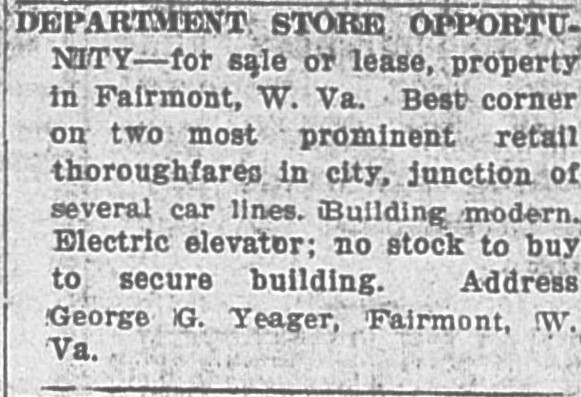
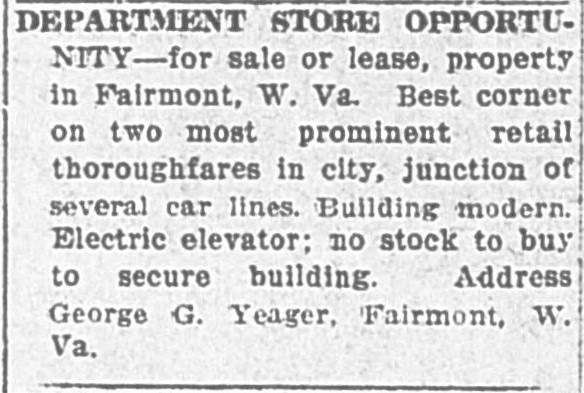
After the store was empty of merchandise from the huge sale, he leased the building to a merchant that would become a staple for Fairmont. E. C. Jones was a man that owned a store in Mannington, W.V., and ran it with his brother. Since being the entrepreneur that he was, Fairmont seemed the place to grow his business. This was in 1905. His brother would continue running the business in Mannington.

When he leased the Yeager building, there were other tenants on the top two floors. McCray Systems, an outdoor advertising firm, a dentist named Richard E. McCray and Galliers Clothier. Yeager said they were all staying because their leases were still good. Plus, he had leased a small space beside the building on the Madison St side to a man with a fruit stand. Jones was happy with just the first floor and basement.
He ran his business very successfully for about three years and none of the other tenants bothered him except the man with the fruit stand. When he was open,his customers would stand around the front of the store, blocking the entrance to Jone’s place. Furthermore, when the weather was hot, flies and insects were everywhere, even coming into the store. The straw that broke the camel’s back was when the fruit stand man wanted to make an enclosed shack beside the store; Jones had had enough, He realized that Yeager had made the deal with him, but he was off vacationing and could not be reached. Jones took his problem to the city council and filed a complaint. Jones was known for being a fair, easy-going prominent businessman. The council looked at the problem and decided that there would not be enough room for a structure to be built between the building and the sidewalk; the verdict went in Jone’s favor. The fruit man was asked to move elsewhere.
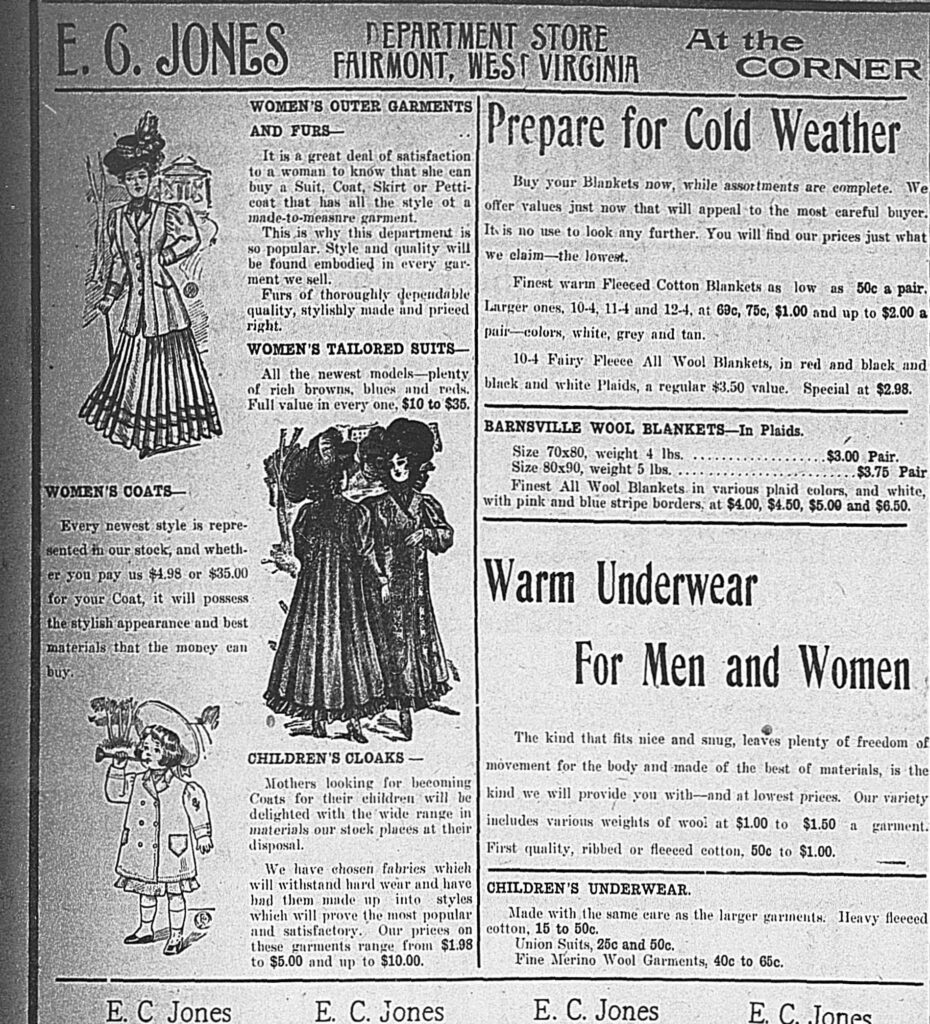
Jones store continued for two more years before it started growing out of its space. By this time, the leases were also up for the other tenants and the entire top floors were empty. Jones was aware that there was another option to his problem. A new building that had been built further down Main St, called the Jacobs and Hutchinson building. It was also designed by the same man that designed the Yeager building, Andrew Lyons. It was larger and much grander looking than Yeagers. Jones was able to contact Yeager now and said he would not be renewing his lease. Jones moved his store in the location that would be a staple for Fairmont for many years. He eventually moved his business to the new Middletown Mall and remained there untill the business closed.
Yeager would continue to own the property and building, but he would lease the building now to Mr. A. Harrison for ten years. This was in 1910. He was also a merchant in the area who wanted to expand his business. In Yeager’s former sale, Harrison had acquired some of his stock. When asked how he had been able to grow, Harrison replied, “Liberal use of money in newspaper advertising and careful buying.”
Harrison’s was the name over the door and it got the reputation of being known as the”Economy Department Store.” He had 16,000 sq. feet of selling space and 70,000 to 80,000 dollars of stock. The store had 27 clerks to help customers, which was unheard of at the time.
Harrison’s did everything bigger and better than other competitors. Celebrating the store’s seventh anniversary, Harrison ordered the biggest cake ever made in Fairmont. The Ideal Bakery, also on Madison St., was to make a cake that stood 7ft. 1in tall, with a weight of 437 pounds. It would have seven layers. One for each year in business. The cake would be placed in front of the arched glass windows for the whole town to see.

Harrison would continue with his business till the end of his lease in 1920. Then he decided to retire just as his landlord had done.
George Yeager, who had been in failing health for a while, was in Philadelphia at this time, where he was staying with a relative. He had been one of the unfortunate with influenza in the 1918 outbreak. He never really got over it completely. Yeager would give power of attorney to his wife over the building and she leased it to two brothers that would be the last tenants of the building before it was demolished in 1985. George passed away in Garrison hospital in Philadelphia from pneumonia and his body was brought back to Fairmont for his funeral, and he was laid to rest at Woodlawn cemetery.
Julius and Isreal Golden were the last tenants. They named the store Golden Bros. and turned it into one of the best department stores in town. They had it all. They sold clothes, housewares, shoes, and anything you might require. I remember shopping there when I was a little girl with my mother for my Buster Brown shoes and Easter dresses for church. It always had the most up-to-date merchandise. Julius was the buyer for the store, and Isreal was the manager. People would go on to refer to the store as the Golden Corner. The store was run on cash, no credit, at least at first.
Julius and Isreal would continue to work together until Julius passed away, and then his son Jack would take over for him. It was sad to see the store deteriorate as customers left to shop at the new Middletown Mall. The town that was a mega center for shopping was starting to look like a ghost town. After Golden Bros closed in 1979, the store sat empty for six years until it was demolished and turned into a parking lot for the new post office. So sad.
When they did the survey of the building before it came down, they found the building was still in pretty good shape. It was a shame no one wanted to put it to use; below are some old Golden brothers pictures after it was closed and ads from the newspapers.
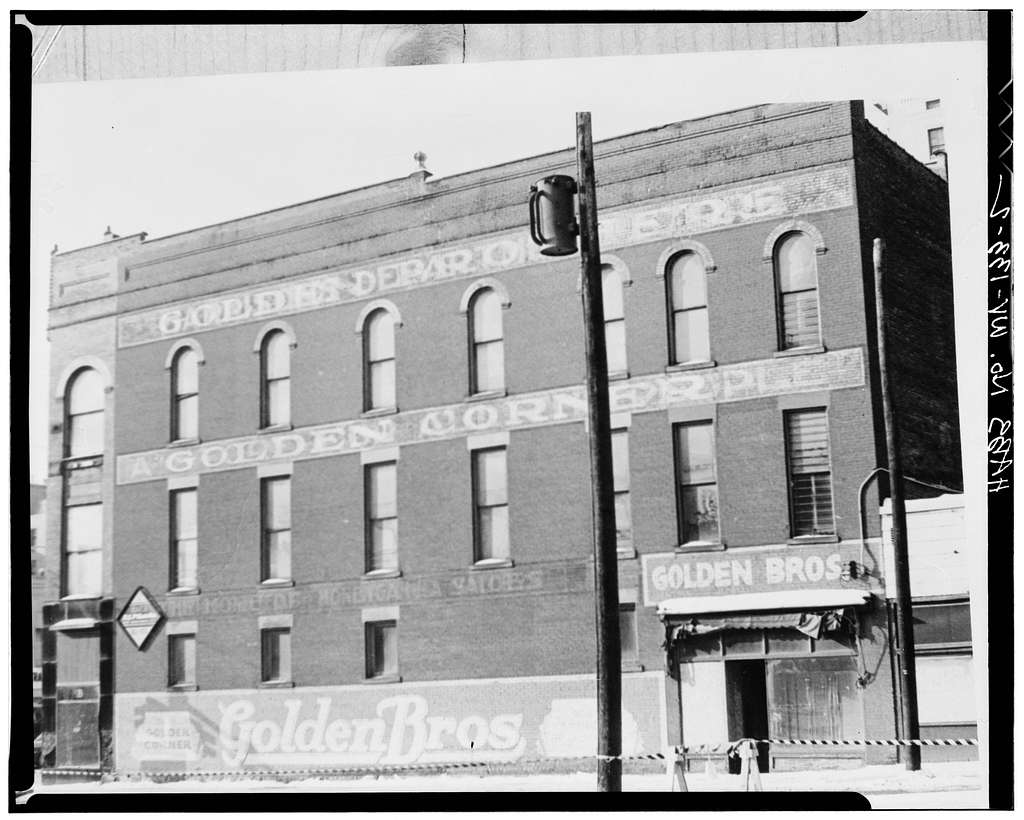
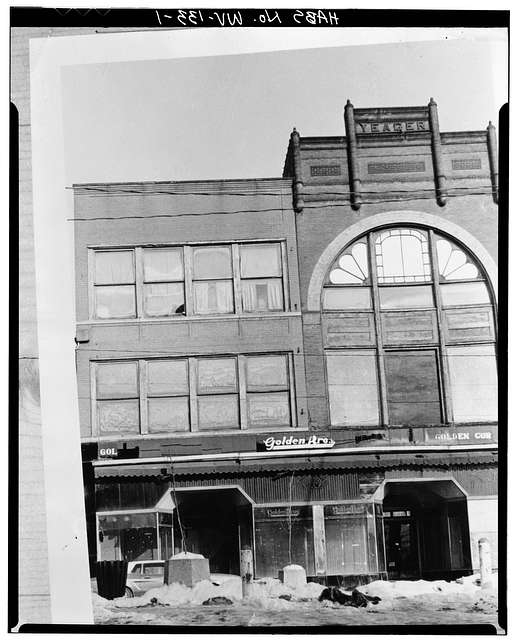

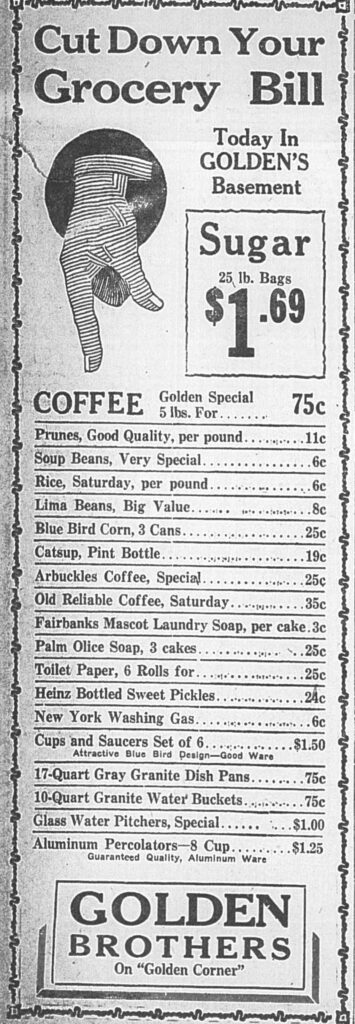
I will publish a new weekly blog containing more Fairmont and Marion County history. If there is a topic you may want to explore more, please comment below, and I will research it. Please comment below, letting me know if you did or didn’t like this article. It helps me improve with your suggestions.
Thank you for taking the time to read my blog, and remember: History is the spine of America; not learning from it would make us collapse and fall!

I, too shopped at Golden Brothers for my Easter dresses, shoes, and gloves though the store was in decline then. I also have a memory of purchasing one of my first bathing suits — it was rainbow striped and had cute cut-outs on each side. At this time, they were still carrying very fashionable, current clothing. As a curious child, I remember wandering off and happening upon a man smoking a cigar in a dusty office, who must’ve been Mr. Golden.
Thanks for the interesting history in the building; I had no idea of it’s prior to Golden Brothers life! I would suggest enlarging this typeface or using the bolder version to help readability. Thanks!
Thank you for your comment and suggestion. This is why I ask for comments to get feedback to help me improve the blog. I’m sure you saw Mr. Golden, and yes, it was many people’s go-to for school clothes. It seems that the building was destined to have great stores. thanks again and I look forward to hearing from you again!
So interesting for those of us who grew up and recall downtown Fairmont with such fond memories. It was such an experience to shop there – even in winter with snow on the ground and heavy coats and hats which came off when you were shopping and pulled back on before return outside to travel to the next store. I bought my homecoming dress at 14 and it was the prettiest turquoise color with sheer sleeves and overlays. It was too tight but they didn’t have my size, so they “let it out” as much as they could. Still snug but I loved the dress so much. My mother should have been with me shopping that day! GC Murphys was my favorite store as a kid – they had things I could afford with my meager allowance! I would love to see the history of that store.
Hi Carol,
Thanks for your comment. Yes, shopping in downtown Fair was a fun time for us all. Too bad we can’t still shop in downtown as we used to. G.C. Murphy’s was the center of the whole town, it seemed. I will put your request for its history on my list.
I got good info from your blog.
Hi,
I”m so glad you found it so interesting. Thank you for reading. I look forward to hearing from you again.
Fantastic blog! Having read this I thought it was very informative.
Thank you very much for your comment.I’m glad you appreciate all the information I am trying to bring. Thank you again!
Good one!
Thank you so much!